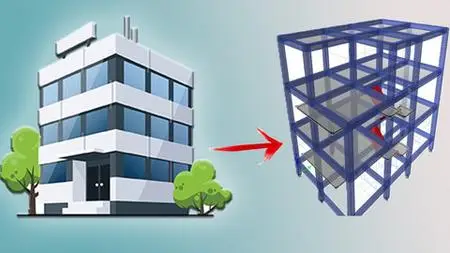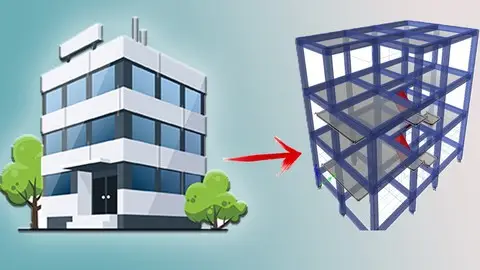Etabs: For Structural Design Of Buildings
Last updated 5/2020
MP4 | Video: h264, 1280x720 | Audio: AAC, 44.1 KHz
Language: English | Size: 3.99 GB | Duration: 7h 1m
Last updated 5/2020
MP4 | Video: h264, 1280x720 | Audio: AAC, 44.1 KHz
Language: English | Size: 3.99 GB | Duration: 7h 1m
Structural Analysis and Structural Design of Residential Building in ETABS with Real World Project.
What you'll learn
Learn structural analysis and design of a residential building using ETABS.
Detail and design the column and beam longitudinal and shear reinforcement.
Analyze and design any kind of civil engineering structure using ETABS.
Free access to the basic course of ETABS that is available in my profile.
Export the designed data to excel for further calculations.
Do preliminary design of structural members.
Calculate lumped mass, base shear and strorey shear.
Requirements
Basic knowledge of computer.
ETABS ( Any version) installed in the computer.
Description
Description of The CourseThis course titled " ETABS: Structural Analysis and Design of a Building" teaches you all the things required for the structural analysis and design of a residential building. This course doesn't require you to have any prior experience in this software or any other structural design software. It will teach all the aspects of the software from very basic and will take you to the higher levels of the software as the course progresses. The course has been very systematically arranged so that you can best understand the software. Once you complete this course, you will have all the necessary knowledge to do the structural design of a building. You can do the structural design of buildings on your own projects. We spent years at college but yet there are some topics that are overlooked in the engineering syllabus but are important in working fields. This course titled " ETABS: Structural Analysis and Design of a Building" has been created in order to fill that void and help students start out with structural design software. ETABS is a structural analysis and design software developed by csiamerica. It is a very powerful software that can design almost any kind of civil engineering structure.ETABS is used for the design of beam and columns only. Howeever, this course also contains the design of slab and the footing. Unlike other courses available online which only teach you tools of ETABS and not the actual process of analysis and design, this course takes a real-world architectural drawing of a building so as to explain the entire process from modeling up to the design.
Overview
Section 1: Introduction To The Software
Lecture 1 The User Interface
Lecture 2 Download and Install the Software
Lecture 3 Introduction to the Grids
Lecture 4 How to Speed up to Slow down the Lecture speed?
Lecture 5 Modelling of a Continuous Beam
Lecture 6 Analysis of The Continuous Beam
Lecture 7 Analysis of a Truss
Section 2: Preliminary Design (Optional)
Lecture 8 Introduction
Lecture 9 Preliminary Design of Slab
Lecture 10 Preliminary Design of Beam
Lecture 11 Preliminary Design of Column
Section 3: Modeling of Building
Lecture 12 Read Architectural Drawing
Lecture 13 Define Grids
Lecture 14 Define Materials
Lecture 15 Define Section Properties
Lecture 16 Correction of Grids
Lecture 17 Modelling Up To Ground Floor
Lecture 18 Modelling of First Floor
Lecture 19 Modeling of Second and Third Floors
Lecture 20 Extruding the Model
Lecture 21 Modeling of Balcony
Lecture 22 Assigning Support to the Model
Lecture 23 Lowering The Tie Beam
Section 4: Modeling of Staircase
Lecture 24 Read Architectural Drawing of Staircase
Lecture 25 Define Reference Points and Reference Planes
Lecture 26 Model Staircase From Ground Floor to First Floor
Lecture 27 Model The Landing Beam
Lecture 28 Model Staircase From First Floor to Second Floor
Section 5: Advanced Modelling Options
Lecture 29 Model Secondary Beams
Lecture 30 Model Curved Beams
Lecture 31 Different Modes of Modelling a Beam
Lecture 32 Offsetting The Beam While Modelling
Lecture 33 Modelling Circular Columns
Lecture 34 Modelling Eccentric Columns
Section 6: Load Application
Lecture 35 Defining Load Patterns, Diaphragm and Mass Source
Lecture 36 Application of Partition Load
Lecture 37 Application of Shell/ SLab Load
Lecture 38 Application of Wall Load on Slab/Shell
Lecture 39 Meshing of Slab and Frame Structures
Section 7: Calculation of Seismic Weight, Base Shear and Storey Shear (Optional)
Lecture 40 Introduction
Lecture 41 Seismic Load Calculation
Lecture 42 Base Shear Calculation
Lecture 43 Storey Shear Calculation
Section 8: Application of Lateral Loads
Lecture 44 Application of Lateral Loads Introduction
Lecture 45 Application of Earthquake Load Method-1
Lecture 46 Application of Earthquake Load Method-2
Lecture 47 Application of Earthquake Load Method-3
Lecture 48 Application of Wind Load
Section 9: Load Combination and Structural Analysis
Lecture 49 Introduction To Load Combinations
Lecture 50 Defining The Load Combinations
Lecture 51 Analyzing The Building
Section 10: Design Of The Building
Lecture 52 Design Of The Building
Lecture 53 Redesigning the Columns
Section 11: Design Checks To Be Performed
Lecture 54 Check for Section Failure
Lecture 55 Rebar Percentage
Lecture 56 P-M-M Interaction Ratio
Lecture 57 Beam Column Capacity
Lecture 58 Storey Displacement, Storey Drift and Drift Ratio
Lecture 59 Torsional Irregularity
Section 12: Detailing of Column Rebars
Lecture 60 Introduction
Lecture 61 Understanding the Rebar Values of ETABS
Lecture 62 Rebar Combination of the Plinth Level Column
Lecture 63 Sketching the Rebars of the Plinth Level Column
Lecture 64 Detailing the Rebars of the Ground Floor Column
Lecture 65 Detailing the Rebars of the First Floor Columns
Lecture 66 Detailing the Rebars of the Second Floor
Lecture 67 Concept of the Lapping of Bars in Floor Levels
Lecture 68 Concept of Detailing the Columns Having increasing Reinforcement Values
Lecture 69 Detailing of Columns with Increasing Reinforcement values upto First Floor
Lecture 70 Detailing of Columns with Increasing Reinforcement values at Second Floor
Lecture 71 Concept of Detailing of Similar Columns and Preparing Structural Drawings
Lecture 72 Shear Detailing : Getting results from ETABS
Lecture 73 Calculating the Required Spacing of the Lateral Ties
Lecture 74 Detailing of the Lateral Ties
Section 13: Detailing of Beam Rebars
Lecture 75 Overview of the Structural Drawing of Beam
Lecture 76 Studying the Results of ETABS
Lecture 77 Detailing of Top Mid Bars
Lecture 78 Detailing of Top Extra Bars
Lecture 79 Finalizing the Top Bars
Lecture 80 Detailing of the Bottom Reinforcement
Lecture 81 Grouping the Beam Details
Lecture 82 Detailing the Bars at the Beam Junction
Lecture 83 Concept of Lapping of Bars
Lecture 84 Detailing of Extra Bars at the Bottom
Lecture 85 Important Point to Remember
Lecture 86 Calculating the Stirrup Spacing
Lecture 87 Providing The Shear Reinforcement
Section 14: Exporting ETABS Results To Excel
Lecture 88 Export Model Results
Lecture 89 Export Analysis Results
Lecture 90 Export Center of Mass and Center of Rigidity Values
Lecture 91 Export Design Results
Section 15: Design of Slab
Lecture 92 Introduction
Lecture 93 Inputs for Slab Design
Lecture 94 Calculation of Slab Moments
Lecture 95 Calculation of Area of steel
Lecture 96 Detailing of slab (Brief)
Lecture 97 Design checks to be performed
Section 16: Detailing of slab
Lecture 98 Slab Reinforcement Overview
Lecture 99 Reading the Structural Drawings of Slab
Lecture 100 Detailing of Bent up Bars
Section 17: Design Excel Sheets
Lecture 101 Design of Slab
Lecture 102 Design of Isolated Footing
Lecture 103 Design of Raft Foundation
Lecture 104 Design of Staircase
Lecture 105 Design of Beam
Lecture 106 Design of Column
Section 18: What Next?
Lecture 107 What Next? (Bonus Lecture)
Civil engineering students who wish to learn ETABS for structural analysis and design.,Civil engineering graduates who wish to pursue their career in structural analysis and design of buildings.,Graduates doing project on building design.



